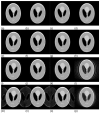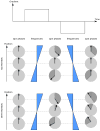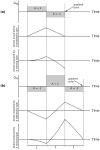Motion artifacts in MRI: A complex problem with many partial solutions
- PMID: 25630632
- PMCID: PMC4517972
- DOI: 10.1002/jmri.24850
Motion artifacts in MRI: A complex problem with many partial solutions
Abstract
Subject motion during magnetic resonance imaging (MRI) has been problematic since its introduction as a clinical imaging modality. While sensitivity to particle motion or blood flow can be used to provide useful image contrast, bulk motion presents a considerable problem in the majority of clinical applications. It is one of the most frequent sources of artifacts. Over 30 years of research have produced numerous methods to mitigate or correct for motion artifacts, but no single method can be applied in all imaging situations. Instead, a "toolbox" of methods exists, where each tool is suitable for some tasks, but not for others. This article reviews the origins of motion artifacts and presents current mitigation and correction methods. In some imaging situations, the currently available motion correction tools are highly effective; in other cases, appropriate tools still need to be developed. It seems likely that this multifaceted approach will be what eventually solves the motion sensitivity problem in MRI, rather than a single solution that is effective in all situations. This review places a strong emphasis on explaining the physics behind the occurrence of such artifacts, with the aim of aiding artifact detection and mitigation in particular clinical situations.
Keywords: MRI; motion artifact; motion correction; motion prevention; review.
© 2015 Wiley Periodicals, Inc.
Conflict of interest statement
There are no financial interests or commercial products associated with the presented material.
Figures







References
-
- Wood ML, Henkelman RM. MR image artifacts from periodic motion. Medical physics. 1985;12:143. - PubMed
-
- Van de Walle R, Lemahieu I, Achten E. Magnetic resonance imaging and the reduction of motion artifacts: review of the principles. Technol Health Care. 1997;5(6):419–35. - PubMed
-
- Le Bihan D, Poupon C, Amadon A, Lethimonnier F. Artifacts and pitfalls in diffusion MRI. Journal of Magnetic Resonance Imaging. 2006;24(3):478–488. - PubMed
-
- Kiselev VG, Hahn KR, Auer DP. Is the brain cortex a fractal? Neuroimage. 2003;20(3):1765–74. - PubMed
-
- Paschal CB, Morris HD. K-space in the clinic. Journal of Magnetic Resonance Imaging. 2004;19(2):145–159. - PubMed
Publication types
MeSH terms
Grants and funding
LinkOut - more resources
Full Text Sources
Other Literature Sources
Medical

